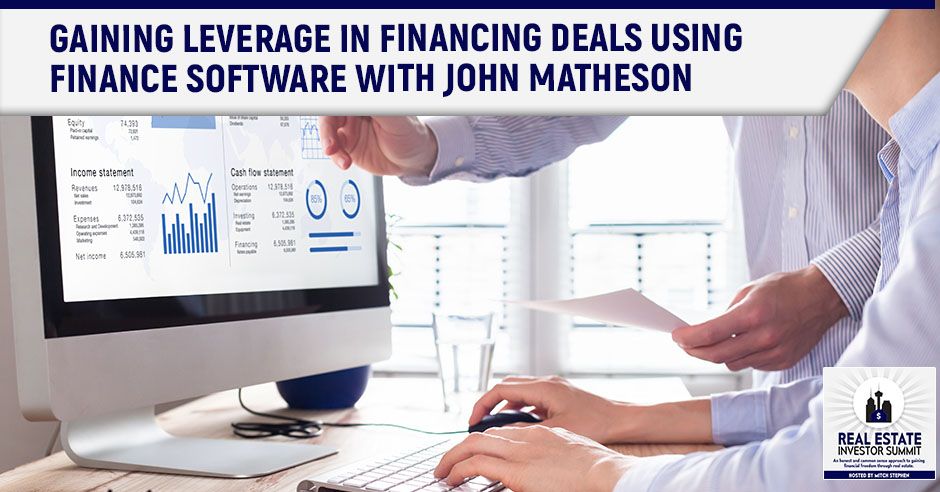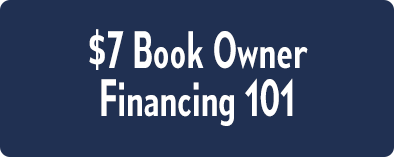PODCAST
Gaining Leverage In Financing Deals Using Finance Software With John Matheson
Episode 385: Gaining Leverage In Financing Deals Using Finance Software With John Matheson

Who wouldn’t want to know what the property can be financed for before applying for a loan? With the right tools, you can now gain leverage in financing deals by knowing what your property is worth and how much banks are willing to put in it. It sure feels great to be empowered in these conversations by having the right numbers up your sleeve. John Matheson, the CEO of Leverage, talks about how this can be done through software as he joins Mitch Stephen on the show. John is a real estate developer who has pivoted into software after discovering that it is an underutilized tool in the commercial lending space. His company now helps investors determine the maximum financing amount for their investment property before even talking to a lender.
—
Watch the episode here
I’m here with John Matheson. He has a software company, Leverage Finance. He’s also a real estate developer. We’re going to get started. Let me pay homage to our sponsor, TaxFreeFuture.com. If you don’t have a tax-deferred or tax-free retirement plan in which to grow your finances, you’re missing a huge tool in your tool belt. Please go to their website. We’re going to tell you what your financial advisors are not telling you and you won’t believe it. We’re going to tell you why they’re not telling you, then you can make your own decision. There are 37 little video vignettes there. Give us your little micro information and we’re going to open your eyes to how fast you can grow small amounts of money in a tax-free or tax-deferred environment. TaxFreeFuture.com, thank you. John, you’re a real estate developer gone software CEO. How does that happen? Give us a little background.
It happens when you live through recessions. This will be my fourth. We have been around long enough where the first one that we went through was in the late ‘80s, early ‘90s. That one was when we all figured out how to buy stuff. The last one in 2008, 2009, all of our friends in commercial banking decided to get defensive that they weren’t lending to us the right way. When we came out of that recession, our balance sheet built and how we did it was with either private lenders, as you’re familiar with, or we did it with institutions that were more capital-based than bank lending.
Coming out on the other side, we realized there was such a disconnect between those of us who invest in quality real estate and the funding sources that we thought we should try to come up with a way to be able to communicate better. That’s where we hatched the idea of software. If you think of it, all the time that you’ve been in this business and I have, we’ve never had software as the buyer or the borrower that we could use in commercial. In residential, they’re everywhere, but in commercial to be able to prequalify ourselves for a commercial loan on a property before we ever speak to the lender.
The way we would be playing for that is to get your collective BS together before you start shopping.
The thing of it is who wouldn’t want to know what the property can be financed for before they apply? You get into investment space where you have over five units in one building that’s cashflowing and you want to buy it. The seller is asking God knows how much million dollars for it. You got to put 25% down. How do you know the bank is going to be there or the lender? They will be there with that $750,000. You’re going to write a purchase and sale, and start paying for due diligence. We all know as we get into this space, one of the biggest problems is the re-trade halfway through a transaction and due diligence that happens because your lender says, “We can’t do that $750,000, we can only do $680,000 on the property.” You don’t get explained why. We wanted to solve that ourselves because we all have our own little back of the napkin or back of the envelope way of trying to figure out if property works before we’ll even buy or look at it. I’m sure you have the same type of systems we do.
My father would look at stuff and he had four little inputs that he’d do on the back of a piece of mail. If it didn’t work, we didn’t do the transaction. It’s the same thing with the software. How do you make it easy? That’s how we got from real estate developers to software. We’ve got people who use this thing to be able to know before they apply what the financing thresholds of a property are. They can help establish their asking price. If you’re a seller, you know what people can finance on your building before you even establish an asking price.
They might have a place they can go to.
We do have that too, which comes out of this nice little fund that we’re having across the nation.

Gaining Leverage: There is a disconnect between those who invest in quality real estate and the funding sources. There should be a way for them to communicate better.
There are a lot of different kinds of people in this audience. Some of them may only have 10 or 15 houses. They’re not big boys and they’re not commercial, but you can bundle up those houses and move them into some commercial space as far as the lender is concerned.
When I started, I bought my first house at $30,000. We all start somewhere and then you grow. You then get to be our age and it’s funny, your resume is long. It’s long because you did a lot. There’s still that old Will Rogers adage, “Even if you’re on the right track, you’ll get run over if you sit there.”
Even a broken clock is right twice a day.
You sit there and say, “How do I grow this business?” You need to have some form of legitimate financing. If you’re somebody who’s buying in this era versus the ‘90s when we were all rolling. This era is a lot harder to get the inventory in cost-effective in different parts of the country, especially you get into 4, 5, 6 units of single-family and you say to yourself, “I want to level up. I want to get into that apartment building space where all my rents are under one roof.” What you need is a commercial loan facility to do that. The first place to start is by using the modern tools that are available to you to be able to communicate with a lender.
When you get into Leverage Finance Software and you look at it, and you take the Leverage Report that it generates and you hand it to a lender, you suddenly look prepared for what you’re proposing, which is one of the real value adds that people tell us about the software. They can walk-in and the lender goes, “Where did you get this?” It starts the conversation differently than the way we’ve all started it in the past, which is we walk-in with our little presentation, as you say our BS put together. We put it in front of the lender. We do a nice little presentation and we all do the same darn thing for the next week. The four-letter word that starts with a W and ends with T, we wait. It’s a technology-driven world nowadays. Why do we have to wait? As a lender, why can’t you answer me right now? Here’s the technology report that says, “I have gone through your pre-commercial writing guidelines and it says, ‘I’m a go.’ Would you like to continue the conversation with me on this property, yes or no?” It makes it easy to start that lender conversation.
Also, banks will go a lot further with you or explore at least a lot further if it looks like you know what you’re doing and you look organized.
You’ve hit it right in the head. What we find as we speak to the lenders is, they all tell us that they hate to tell the borrowers no. The lenders say they don’t enjoy that part, but that the borrowers or all of us come in with either unrealistic expectations or were unprepared. That’s their position.
They don’t have enough documentation to satisfy their underwriting.
One of the biggest problems in financing deals is the re-trade halfway through a transaction. Share on XThey look at it as it costs them money to deny us. They don’t like that. A lot of times, they’re looking to shut us down right out of the gate with the conversation. Many of them have moved their methodologies of intake online because it’s less time for them. The old days when you and I started, you walk into the banker, you shake their hand, they’d write you a check, and you do the documents later. What we like is a new way to start the conversation with the lender is on one piece of paper. We put our information, if I’m going to buy a property, not single-family, it’d have to be multifamily.
If I’m going to use the commercial codebook for lending, I put my information to the Leverage Software that I picked for the property I have. It takes me five minutes to input and it generates me a report. I send it to the lender and I’ll say, “Do you want to continue the conversation on this or not?” The lender knows what that means because Leverage is third-party software that’s showing me my transaction works. If they don’t do it, the favorite word of any capital raiser that you have to know is the same as the barber who’s doing these haircuts and there are ten men waiting for the cut. One guy’s getting cut in the chair and says, “I don’t like my haircut. Can you fix it?” The barber looks at the guy and said, “Next.” He doesn’t have time to fix it. He’s got ten more people waiting. With a lender, it’s next. If you’re in the digital world and you’re attaching this stuff to an email and you’re sending it to lenders, they have to answer you quicker than the old way, which was doing a big presentation, hurry up, and wait.
How much does the software cost or what can someone expect to pay for this?
When we sat and looked at it, the cost of software is insane. One of the things about the property, you can always get a grip on what it costs to buy a piece, develop it, and then what you’re going to put into it before you sell it or keep it. With software, it seems like the cost when you build the thing, it goes up and it’s all in space. You can’t see it. I like the property where I can jump up and down on it. This darn tech, I can’t touch and feel the same way. We looked at it and said, “We think we can help a lot of people.”
Our goal is to get this in the hands of as many investors as we can. We kept the price down to where you can get an annual subscription for $197. It allows you to vet as many transactions as you want before you ever speak to a lender and maintain a dashboard so that when you go to refinance in a couple of years, you have all your original data that’s in place from your first application. You can use that to show the lender how you’ve performed on your building for the last couple of years. People are using it in this Corona environment to refinance to get cash out, to be able to survive this crisis we’re in.
First of all, $197 is a great price. It’s a non-issue if you’re anywhere remotely in this space. I want everyone to go REInvestorSummit.com/leverage. Over there, we’ll have everything that you want to put in there, John, to contact you, any samples, anything you want to give away, ways for people to get ahold of you so they can get a consult and get their arms around this. You’ll be able to show people probably on a Zoom or something. Give us some case studies. How has this helped?
It’s funny, in commercial real estate space. I’ll give you a couple of classics. A young man, to me, is someone in their twenties. He purchases the software, he gets a report, and he walks into a lender. He walks into a bank. He’s buying multifamily. It was a five-unit transaction, but he’s got his purchase and sale. He’s got his output report. He walks into the bank and it so happens that he’s in an institution where the tellers are on the first floor, but there’s some commercial lending on the second floor. He’s in one of those types of branches. He meets the business development manager for the bank. He says exactly what we tell him to say, which is, “I bought a third-party software that tells me my transaction’s a go for the multifamily property I want to buy. Would you like to continue the conversation with me?” He sets the report on the desk, sits back, and doesn’t talk.
The business development manager looks down at the report and says to him, “Can you hang on for a moment? I got it. I’ll be right back.” She goes upstairs. She brings down a senior vice president from lending. He looks at the report and asks him where he got it from. He tells him he bought a third-party software online. The guy reads the Leverage Report and says, “Young man, you are one of the most prepared borrowers that had walked into this institution. Of course, we’d like to continue.” Our help desk gets a call and he’s like, “I’m feeling good. I’m going to negotiate the rate.” I’m like, “Don’t negotiate the rate. Take your first deal and be good with it. It’s a bank. There will be prime plus something.” That is one of my favorites for people who are starting out and getting some benefits from being able to start the conversation differently.

Gaining Leverage: With the right software, people are able to know the financing thresholds of their property before they even apply for a loan.
Let’s talk about that negotiating rate. You don’t have to confront them at all, but you ask them for a letter stating what the terms they’re offering. It’s the letter of intent. They give you a letter of intent with all the particulars about the loan and the opportunity that they’re offering you. You can take that letter with your report and put that letter on top of the report and go to the next bank or go to five banks and make them compete. When I was first in this business, first of all, I had to be loyal to the person that gave me my start because I didn’t walk-in organized. They organized me and got my collective crap together. They gave me a $500,000 line of credit. He was my best friend from high school, the high school quarterback. I was the tailback and there was loyalty there.
I knew he was charging me half a point or a point over and there were some things, but I wasn’t going to argue with him because, without him, I’d never even got a commercial loan. When he left that bank and went to another bank that didn’t do what I do, I became a free agent. All the other people that I dealt with in that bank had moved on to other banks too. All of a sudden, I could take letters of intent from anybody and everybody and pick the best one. I’ll put it on everybody’s desk and go, “I’m about to get a loan from somebody. Does anybody want to compete for me?” It’s not unusual and it’s almost expected of you to have other offers and compete. Don’t feel like you’re being a jerk when you go to the banks.
You do always have to take special care of personal relationships. If you owe somebody a favor, don’t make the man compete over a quarter of a point. It’s a good deal. Go down and make your money. Especially if you don’t know banks. You don’t know him from Adam. If they want to get to know you, make them compete. It changed my whole world being able to go out there and have the banks compete for me. They said, “Don’t do what you do.” I hypothecate notes. I pledge notes for lines of credit for fifteen-year fixed, no adjustment loans.
I went to 27 banks and found four that wanted to compete for my business and I found they’re all close. It takes a while. Everything bank specializes. Here’s one key thing I found. It’s not to do with your software, but a tidbit. If I would have been asking all those bankers who turned me down and say, “We don’t do this loan,” “Who do you know that does?” I would have found those four people a lot faster because I thought it would be ridiculous to ask them who your competition that would do this is?
They all used to work for each other. They’re all highly sophisticated and know exactly what all the other banks do because it’s their job to know what the other banks do and know what the other banks’ niches are. I could have found those four banks and probably one day if I had asked the four people that turned me down, “Who does this kind of loan? Who wants this kind of loan?” They should have told me, but I didn’t ask them because I didn’t think it was professional to ask them for one of their competitors, but they do it all the time.
One of the CPA firms that use our software, came back and said, “This is a look under the hood of bank underwriting that I haven’t seen before.” That’s what we did. I partnered with a commercial banker originally to write the code. We know with commercial properties five units or more. We know that they look for three different things right out of the gate. They want our net operating income on the building. They want the debt service coverage ratio on that building, the ability to make those payments, and then they want to get some valuation. With the software, we can give them 2 out of 3. We can give them the net operating income. We can give them the debt service coverage ratio. We can give it to them right away.
That front line banker is a different person than when you and I started, where you were talking to people who could refer you places and tell you. You might have more of an order taker upfront in an institution or electronically, you’re sending something, you can’t even talk to anybody. It’s got to get to the decision-maker and when they see those two things, if the debt service coverage ratio that they require at a particular bank is 1.25, your transaction is 1.55, and you’re covering that well, you’re in a great spot to say, “Look how strong my transaction is. I want a better rate,” or, “I’m going to shop this.” You can because you’re giving them the metrics right up front for how you’re covering your payments. It’s a different way to communicate than we all had.
How complicated is this to figure out? Do you have to take some tutorials or something on this or is it self explanatory?
Know your metrics. Control the conversation and make the lenders want you more than you want them. Share on XI’m an older guy. I grew up where there wasn’t a cell phone. The first one you walked around with a box-like you were in a war movie doing communication. That first one got mounted in my car. I couldn’t believe it. I mandated it had to be easy to use. It takes five minutes to do your input. There are little eyes around the thing that you hover over. It gives you information on tooltips every step of the way. You and I can do it in five minutes or less. Once you do one, you’ve learned how to ride the bike. You just make the thing sing from there.
Here’s a good point. It is helping you to decipher whether the deal is worth doing yourself before you even decided to go to a bank. You’re helping a person size up the property from the get-go. If you’re not meeting certain ratios, you either got to negotiate a better price before you make the offer, or before you consummate the deal, or you have to find a way that you’re going to increase the income to make it worth it or make it bankable.
We have people in that software that use this to establish the purchase price. They won’t even leave their office. The agents will call or they’re on LoopNet or wherever they are. They’re looking at a transaction and they vet it for finance ability first. They won’t even leave the office to look at it until they feel as though it’s a transaction that they can get bank or finance against. Why bother? If the seller is too high, why are we going to re-trade later?
This makes perfect sense. This is a real common sense. You’re charging $197 annually. It’s a non-issue. If that helps save you 25% on a $500,000 loan, it makes $197 looked like chump change. I want you to go over to REInvestorSummit.com/leverage and get hooked up with John Matheson. If you’re interested and you want to take a little deeper dive, get with this company. Let him show you and answer your questions. I appreciate you taking the time to be on this show. Our goal here is to help people find their way, whether they want to be in the business, I’m in or the business you’re in. I don’t care what business they want to be in.
I want them to get independent, get financially free, and be the person that they’re meant to be on this planet instead of a slave to some company or a slave to bills. This is another great asset for the right people. It’s not for everybody. Nothing’s for everybody. If you’re into small commercial or you want to do apartment complexes or you’re looking at strip centers or storage facilities or whatever, this is a great place to start. Get yourself organized and get yourself looking like a pro. I don’t even know how you argue with $197 annually. I’m going to buy it so I can take it over to my office and say, “What can we plugin here?” Anything you want to say to maybe the entrepreneur out there that’s going into real estate?
Everything you said aligns with what we talk about in our boardrooms too. It’s a tough time now. You and I both know, having been through this three times, different contagions each time. This is the fourth time we’ll all get through it. What was it that Churchill said? “Success is not final, failure is not fatal. It’s the courage to continue that counts.” Keep moving through this and you will find somebody. We’ve got a lender right inside the software that represents 110 specialty lenders who will fund you if you have a good transaction. It’s right inside our Leverage Connect. Keep moving to be able to buy the properties that you think are a good value and keep yourself going through this. You will get through it.
It’s not just the software. You also have suggestions for people where to submit.
The lenders came to us and said, “We want to meet people who are making this thing turn green.” As you can imagine, if you can make an underwriting software that says, “Yeah, it’s a go.” The lender wants to meet you. We picked one that represents 110 nationwide and said, “You help the people get it. Get back to them within a day with what’s going on and help them get funded.” We did that based on what’s happening because your audience, as you said, “How can I help your audience?” They’re sitting there saying, “What do I do? Even if I get something, who will finance me?” We went and did that.
Will it work with hypothecation? Can I enter my notes, my cashflow, and my expenses into that? They wouldn’t be properties but they’d be notes. Would it work for note hypothecation?

Gaining Leverage: Lenders hate to tell borrowers no, but many times, the borrowers come in with either unrealistic expectations or a lack of documentation to satisfy their underwriting.
You and I have to take a ride in one of them. I can help you. We’ve got one for multifamily, one for commercial, one for mixed-use, and one for a straight business line of credit, for a credit card, or for an equipment loan in business, term loans. Depending upon what you have, you would enter that in and it’s something that the lenders could take a look at.
Let’s make sure after this call that I get with Julie. Let’s have an hour where I can sit down and explore putting notes into this software. If it does give me the result I want, I’m all in. There might be a whole different audience for you that you’re not even thinking about.
Here’s what you and I know. If there isn’t, we have the programmers who can write that code.
I can’t imagine that it would be that biggest shift over. There’s been a few subtle changes and then, you’re open to people to bundle notes and go to a bank and say, “I want to pledge these notes as collateral and take out all my private lenders and free them up.” That’s what I do. It’s an endless $3 million or $4 million worth of notes. I owe $2 million underneath, and I want to get the $2 million underneath refinance and free up their money. It’s a lot easier for me to buy some of these crappy little properties with a private lender. They would never fly through a bank.
I haven’t had a chance to fix them. I haven’t had a chance to stabilize them. My private lenders have been with me so long, they don’t care. They’re lending money to me and this asset that they have a first lien on. Strike fast while the iron is hot with the private money, but then you get these bundles and they want to take it and get permanently long-term finance at a rate that I can live with and free up my private money again. I can essentially buy the whole town with a handful of private lenders because I keep giving them their money back and then getting it out.
We put in the software, especially in the multifamily, we put in an equity piece. You’re able to show the private investor how you’re going to be able to pay the bank loan. The private investors that you and I work with will say, “I don’t want to put more money in. I’m coming in on the equity side. I don’t want to make your payments for you.” How are you covering the mortgage? The software shows, but then it also will show how to cover the equity investor. You’re in position for a refinance to take them out. You show them how that works in the software. I’ve got people do differ from you, but they do that. They show the private lender how they get in and how they get out using the software. We can make this work.
I’ll get Julie to make us an appointment. We’ll sit down and see how it works or see if we can’t make it work if there are some variables. I’ve been with John Matheson. He’s got some fantastic software for you to use to look like a pro in front of a bank. Check it out, REInvestorSummit.com/leverage. I’d like to thank everyone out there for taking the time to get you some John Matheson. Please stop by and visit our sponsor, TaxFreeFuture.com. You won’t believe what your financial advisors are not telling you. We’re going to tell you what they’re not telling you. We’re going to tell you why they’re not telling you, then you can do with it what you want. It’s a real eye-opener. It’s like one of those things that have been in front of you the whole time. You just couldn’t quite figure it out, but it’s really simple. We’re out of here. Thanks, John. I appreciate it.
Important Links
- REInvestorSummit.com/Matheson
- REInvestorSummit.com/Moat
- REInvestorSummit.com/Livecomm
- REInvestorSummit.com/100
- REInvestorSummit.com/101
About John Matheson
 John Matheson is the CEO of Leverage, a software and education platform designed to help small business owners and property investors make more informed financing decisions. Using the Leverage software platform, commercial borrowers and commercial lenders are able to communicate more effectively and borrowers are able to approach commercial lenders more confidently, already knowing that their transactions are lendable. Through Leverage, John hopes to provide the resources and educational materials that small business owners, entrepreneurs, and real estate investors can use to confidently obtain financing and grow their businesses profitably, all without being at the mercy of the predatory lenders.
John Matheson is the CEO of Leverage, a software and education platform designed to help small business owners and property investors make more informed financing decisions. Using the Leverage software platform, commercial borrowers and commercial lenders are able to communicate more effectively and borrowers are able to approach commercial lenders more confidently, already knowing that their transactions are lendable. Through Leverage, John hopes to provide the resources and educational materials that small business owners, entrepreneurs, and real estate investors can use to confidently obtain financing and grow their businesses profitably, all without being at the mercy of the predatory lenders.
John is also the managing member of J. Healy Development, LLC. The company specializes in developing new projects into sustainable properties. John has been in the property development business for 26 years and has been involved in transactions for developing, permitting, and/or financing of completed projects totaling over $50 million. Through J. Healy, John focuses on making multifamily, mixed-use, storage, and other commercial development properties more green and sustainable, lessening a property’s footprint while increasing its value.











